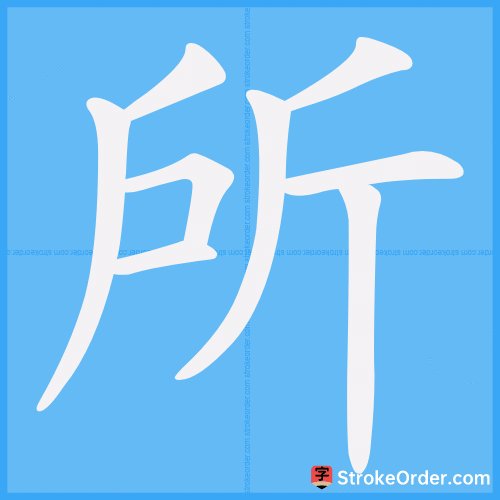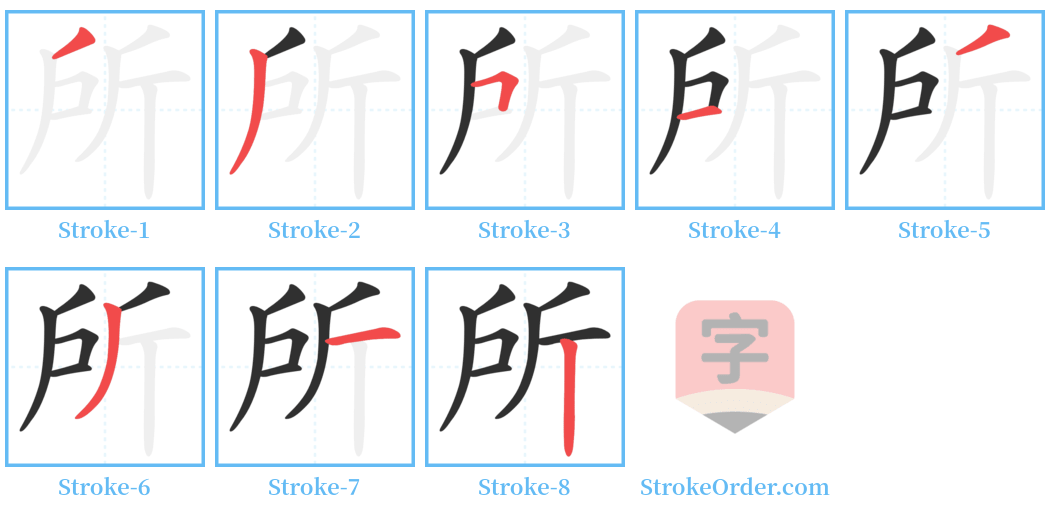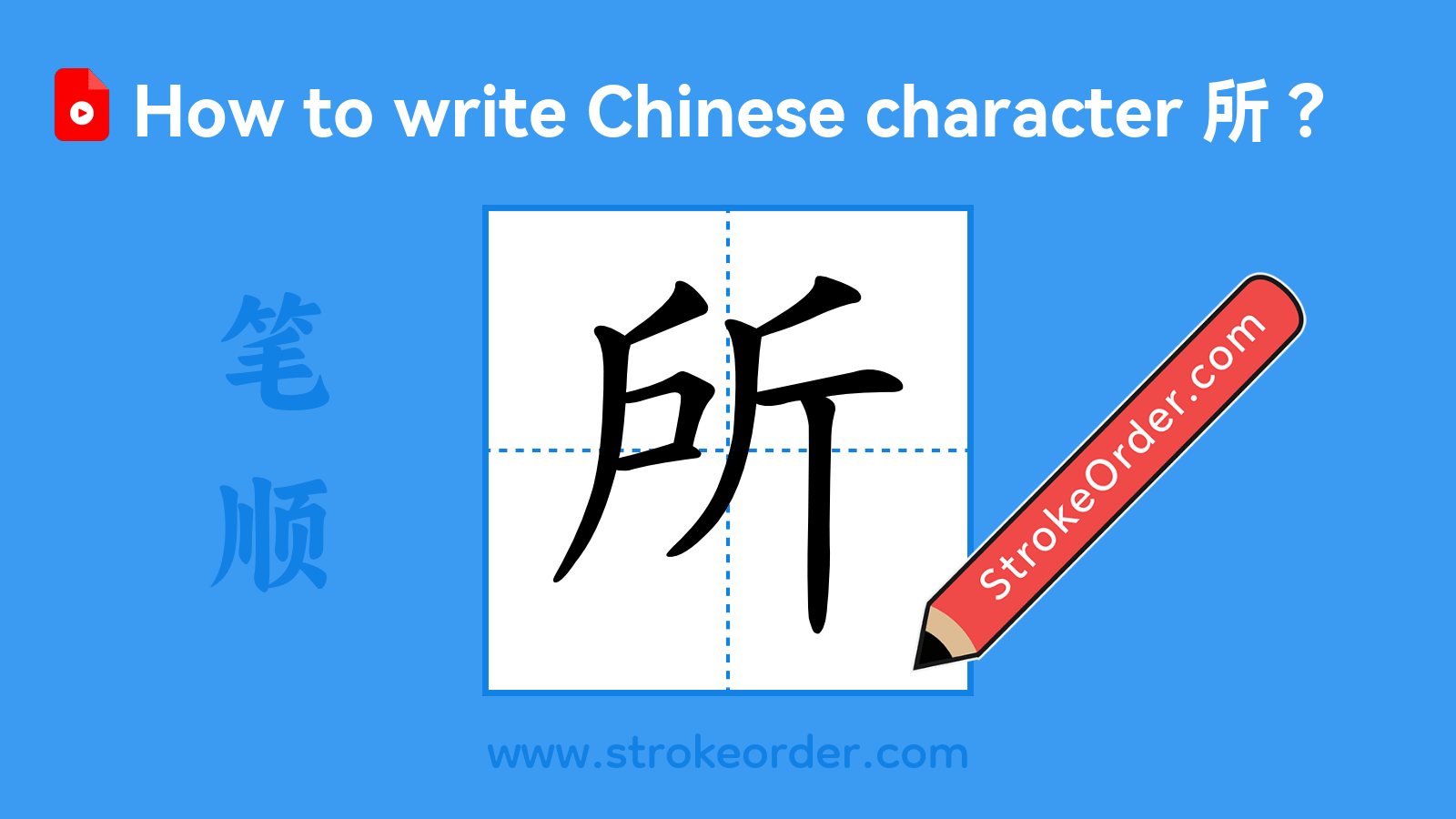所 Stroke Order
Animated Stroke Order of 所

Stroke Order Diagrams for 所

Step-by-Step Handwriting Guide for 所

Learn to Write Chinese Characters with Video Tutorials
Watch the video of writing the Chinese character "所", learn the correct stroke order (笔顺) of the character "所", and master the standard way of writing the character "所".

Free Printable Handwriting Practice with Stroke Order: 所
Printable Writing Practice Worksheet of "所" in Portrait Orientation (Tian Zi Ge)

Printable Writing Practice Worksheet of "所" in Landscape Orientation (Tian Zi Ge)

Information of 所
Pinyinsuǒ
Radical
户
Strokes
8 strokes
Usage
★★★★★
Definition
actually / place
所 [suǒ]名词 (Noun):1. 处,地方:住所 (residence), 哨所 (outpost), 场所 (venue), 处所 (place). - Place; location: residence, outpost, venue, site.2. 机关或其他办事的地方的名称:研究所 (research institute), 派出所 (police station). - Name of an organization or office: research institute, police station.3. 量词,指房屋:一所四合院 (a courtyard). - Measure word, refers to buildings: a courtyard.4. 用在动词前,代表接受动作的事物:所部 (the department led), 所谓 (what is said). - Preceding a verb to represent the recipient of an action: the department led, what is said.5. 用在动词前,与前面的“为”或“被”字相应,表示被动的意思:为人所敬 (to be respected by others). - Indicates a passive meaning when placed before a verb, echoing “为” or “被”: to be respected by others.6. 姓 (surname). - A surname.助词 (Particle):1. 表示结构:用于动词前,和“被”或“为”搭配,表示被动语态。 - Used before a verb or verb-complement to indicate passive voice.2. 与后面的动词结合,构成名词性结构。 - Combines with following verbs to form nominal constructs.3. 用在作主谓结构的谓词前,相当于“之”、“的”。 - Precedes predicates in subject-predicate structures, equivalent to "之" or "的."4. 用作宾语提前的标志,多与“唯”字配合使用,相当于“是”。 - Acts as a marker for fronting objects, often used with "唯": equivalent to "is."5. 与“为”呼应,构成“为…所…”句式,表示被动。 - Forms the "为…所…" structure with "为," indicating passivity.6. 与介词“从”、“由”、“自”结合,组成所字结构,表示与动作有关的地方、原因、对象等。 - Combines with prepositions "从," "由," or "自" to express location, cause, or objects related to an action.7. 和介词“以”组成“所以”这一短语,根据“以”的不同用法与具体语言环境,有不同的意思。 - Forms the phrase "所以" with "以", which can have various meanings depending on the context.量词 (Measure):1. 用于地点、位置,相当于“处”。 - Used for locations, equivalent to "处."2. 用于山、岛等物,相当于“座”。 - Used for mountains, islands, etc., equivalent to "座."3. 用于建筑物。 - Used for buildings.副词 (Adverb):1. 尚,还:尚有未到 (there are still some that have not arrived). - Yet, still: there are still some that have not arrived.2. 大约:有三所 (about three). - About: about three.代词 (Pronoun):1. 这,此:所事者 (this matter). - This: this matter.2. 表示疑问,相当于“何”、“什么”:所为何事 (what matter). - Indicates a question, equivalent to "何" or "什么": what matter.若,如果:如所愿 (if desired).- If: if desired.形容词 (Adjective):1. 一切,所有:一切所需 (all needs). - All: all needs.2. 宜,适宜的:备所需的材料 (materials needed). - Fit: materials needed.3. 许多的,多种的:所用工具 (tools used). - Various: tools used.4. 可以的:所承认的 (permissible). - Permissible: permissible.
Another point
have got to the right place
watchhouse / sentry post
location / site
place / location / (after a noun) place where it is located
location / place
unimaginable / outrageous / freakish
dwelling
one's affiliation (i.e. the organization one is affiliated with) / subordinate (i.e. those subordinate to oneself) / belonging to / affiliated / under one's command
what we do not want to do
fortunately (formal writing)
sanctuary / asylum / refuge
guest house / small hotel
there is not much left
office / firm
printing press / printing office / printer
unscrupulously
to get carried away / to forget oneself
not to hesitate to / will not grudge / regardless of the cost / will never balk at
fearless / have iron nerves / have nerves of steel
without restraint / stick at nothing
all / to have / to possess / to own
so-called / what is called
said
somewhat / to some extent
use / utilize / employ / apply / make the use of
known / what one knows
head of an institute etc
research institute / graduate studies / graduate school / CL:個|个[ge4]
what one acquires / one's gains
Input Method for 所
Pinyinsuo3
Wubi
rnrh
Cangjie
hshml
Zhengma
pdxp
Four Corner
72221
Unicode
U+6240
Same Pronunciation Characters
唆嗦所梭琐索缩锁唢娑挲桫睃羧蓑嗩惢瑣縮鎖莏傞趖摍簑髿簔鮻琑暛溑鎍鎻鏁逤溹蜶鎼䣔㪽䐝䅴䂹䗢䖛䈗䞆䞽䵀
Same Radical Characters
本文来自〆一缕阳光ご投稿,不代表汉字笔顺中文网英文版立场,如若转载,请注明出处:https://www.strokeorder.cn/strokeorder/303.html

 微信扫一扫
微信扫一扫 